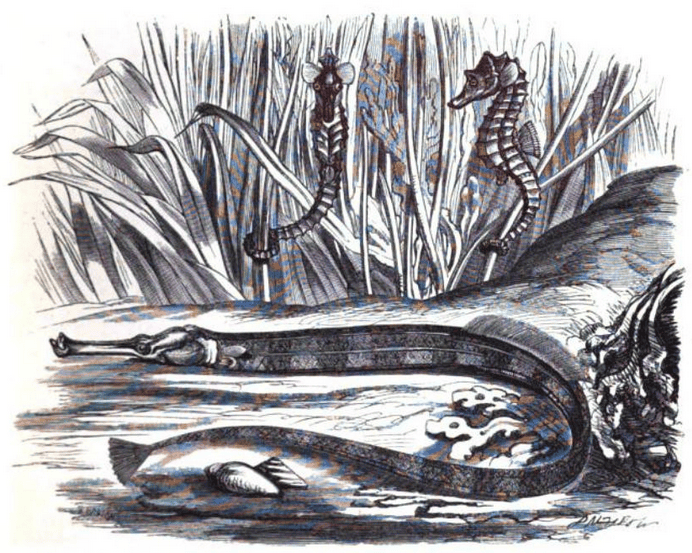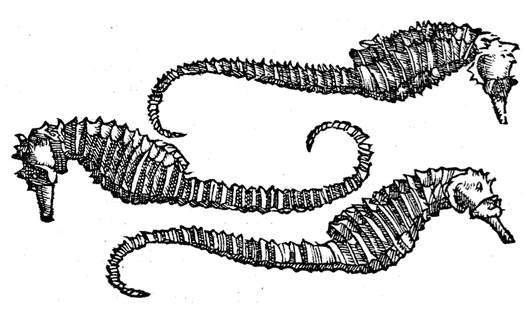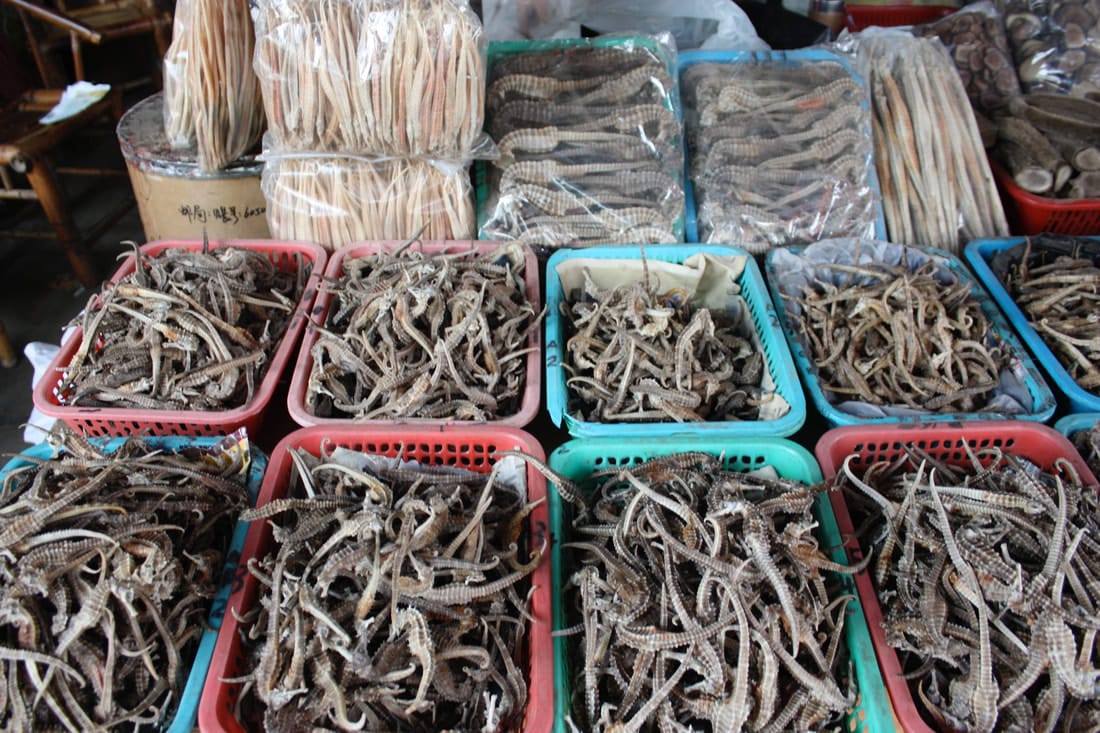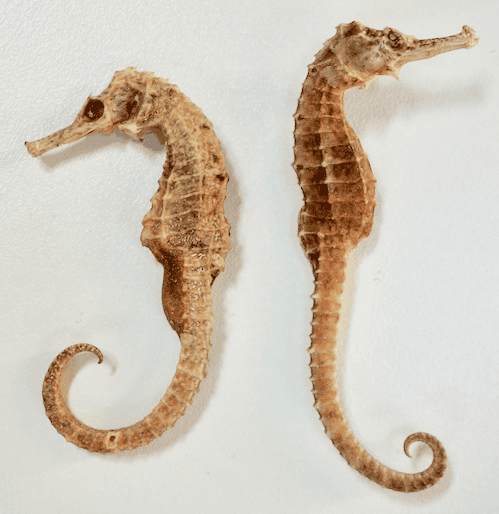Seahorse, Hai Ma 海马Pipefish, Hai Long 海龙 |

|
Pipefish-Hai Long

 Seahorse (Hippocampus spp.) and Pipefish (Syngnathus acus)
Seahorse (Hippocampus spp.) and Pipefish (Syngnathus acus)Illustrated natural history of the animal kingdom, Goodrich, 1859

 A seller at the old Chengdu Medicine Market specialising in Seahorse and Pipefish
A seller at the old Chengdu Medicine Market specialising in Seahorse and PipefishThese types of stalls are no longer seen at the new Chengdu Medicine market. (Adam, 2009)
 Dried Seahorse (Adam)
Dried Seahorse (Adam)Zoological name:
Seahorse: a number of species supply the market:
|
Pipefish. a number of species supply the market:
|
Parts used:
Dried Animal
Temperature & Taste:
Warm, dry. Sweet, Salty
Classification:
N. Tonics
Uses:
1. Strengthens Kidneys, Tonifies Yang:
-Impotence (TCM); Aphrodisiac (Pliny)
-debility in the elderly
-Lower Back pain (TCM); Sciatica (West)
-Paralysis (West)
-Promotes Labor
-Urinary incontinence (TCM, West)
2. Moves the Blood, Resolves Stasis:
-Pain from blood stasis or Trauma
-Scrofula, chronic lymphadenitis
-fixed and mobile Abdominal Masses, Tumors, Cancer
3. Resists Poison:
-swelling due to Sores and Boils (TCM)
-resists Poison (Pliny)
4. Externally:
-ashes applied to Alopecia (Pliny)
-Lichen, Spots on the face ashes of Seahorse mixed with water (Pliny)
Dose:
Seahorse and Pipefish are used in similar doses.
Powder: 1–2 grams
Decoction: 3–9 grams
Often added to large jars of alcohol with other tonic drugs, a small glassful taken daily.
Comment:
1. Seahorse and Pipefish are used similarly and have similar doses. However, some authors have stated Pipefish to be stronger in effect than Seahorse. This supports preferring use of Pipefish as they appear not be to listed by CITES, whereas many Seahorse species are threatened due to over harvesting (mostly for dried curios, not because of Chinese Medicine).
Substitute:
1. Seahorse and Pipefish are very similar in function and uses, both being sources of androgens. They may substitute each other.
2. Gecko or Skink can be used as a substitute. Sea Horse was recommended as a substitute for Gecko (Ge Jie) in some TCM texts.
Preparation:
1. Roasted or Baked Sea Horse:
It can be roasted for use. This makes it more warming, removes some of the smell and facilitates powdering.
2. Wine-Prepared Sea Horse:
The Seahorse or Pipefish is soaked in alcohol briefly, then stir-fried until yellowed and crisp. This makes it more warming, better to move the Blood and resolve stasis, as well as reducing the objectionable smell and facilitating powdering.
3. Ashed Sea Horse:
Sometimes ashed for use, mostly in the West, and usually for external use.
Main Combinations:
1. Tonify Kidney Yang:
i. Seahorse with Velvet Deer Horn (Lu Rong),
ii. Seahorse, Ginseng, Dragon bone, Deer Horn, Gecko, Dang Gui, prepared Rehmannia Shu Di, Walnuts, Astragalus Huang Qi, Clove, Cornus Shan Zhu Yu (equal parts)
iii. Pipefish, Gecko, Deer Penis and Testes, Ginseng, prepared Rehmannia Shu Di, Dang Gui, Astragalus Huang Qi, Velvet Deer Horn (Lu Rong), Dodder seed (Tu Si Zi), Aloeswood, Cinnamon bark
2. Tonify Yin, Pipefish with Donkey Hide Gelation (E Jiao)
3. Urinary Frequency at night, Seahorse, Lycium Gou Qi Zi, Jujubes (Da Zao)
4. Boils and Sores in weak children, make a soup of Sea Horse and Pork.
5. Labor, the Sea Horse can be carried during pregnancy. When close to the due date, the Sea Horse is baked and powdered and taken. Some texts said holding a Sea Horse in the hand during labor facilitated birth.
6. Cancer, Seahorse ashes were given with Bean meal for Cancer in ancient Greece
7. Alopecia:
i. Seahorse ashes, Niter, Hogs Lard (Pliny)
ii. Seahorse ashes mixed wiyj oil and pitch.
Major Formulas:
Cautions:
1. Not used during Pregnancy.
2. Not used for Yin deficient Heat. Also not for Kidney insufficiency or Renal failure..
3. Not used during acute conditions (Cold, Flu etc.).
CITES listing:
A number of Seahorse species are listed by CITES Appendix 2 (those that aren’t presently endangered but could be if trade isn’t monitored).
